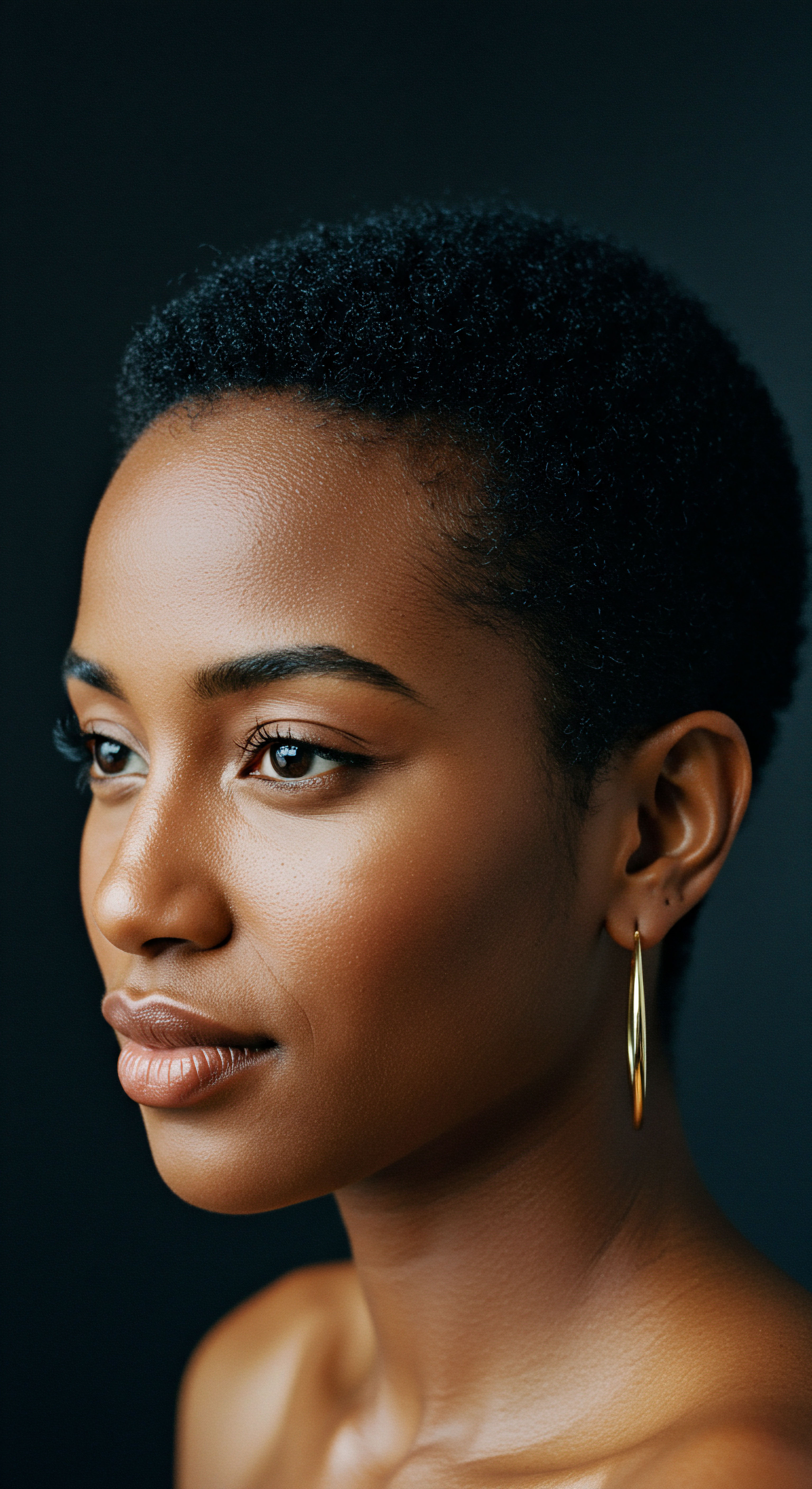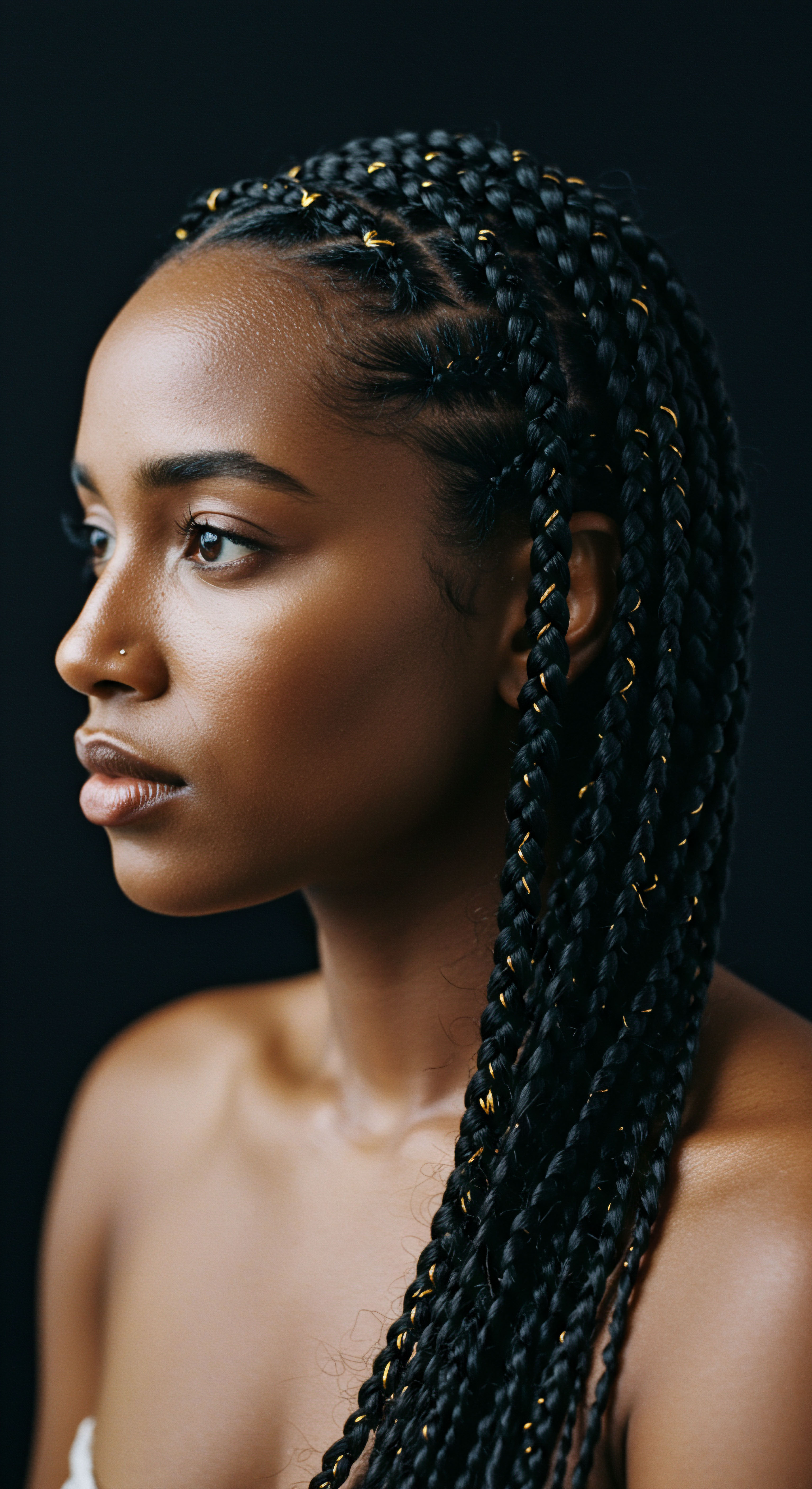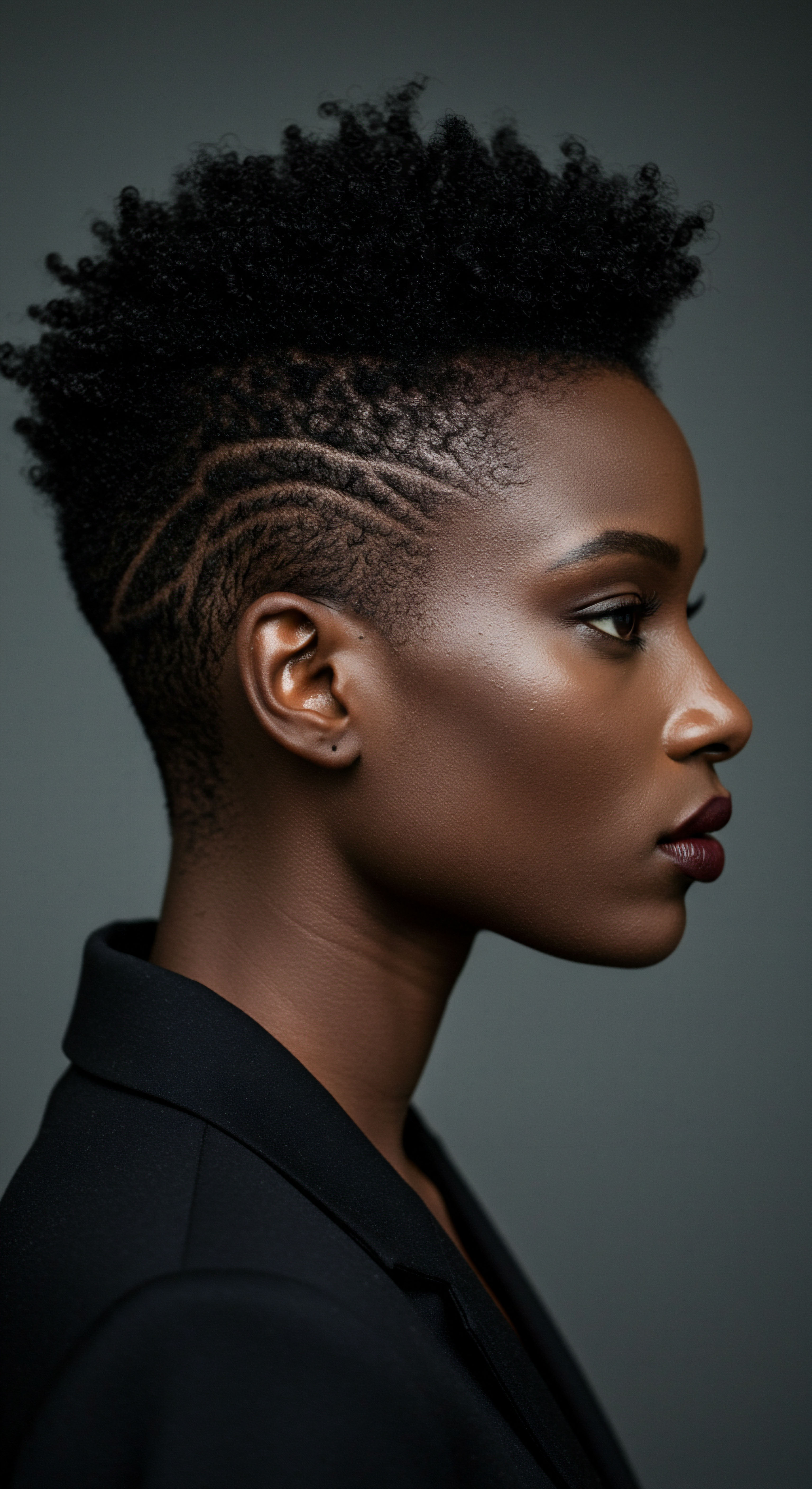
Roots
The intimate relationship between our textured strands and the world around us often sparks a quiet wonder. How do these spirals and coils, so distinct in their form, navigate the ever-changing whispers of the air? At the heart of this enduring query lies a fundamental scientific dance ❉ the delicate interplay of protein and moisture.
To truly understand the vitality of curly hair, we must first journey inward, exploring the very building blocks that grant it both its strength and its remarkable capacity for movement. This foundational understanding allows us to appreciate the intricate mechanisms that dictate how a curl thrives, or perhaps, struggles, in its quest for balance.

The Architecture of a Curl
Each strand of hair, regardless of its pattern, is a complex biological structure, primarily composed of a protein called Keratin. This fibrous protein, forming the bulk of the hair shaft, provides mechanical support and dictates the hair’s inherent shape. A strand’s journey begins within the follicle, a tiny pocket in the scalp that shapes the emerging fiber. For curly hair, this follicle is often asymmetrical or curved, causing the keratin proteins to arrange themselves unevenly as the hair grows, creating the characteristic bends and twists.
Beyond the central medulla (present in coarser hair fibers), two primary layers define the hair’s physical attributes ❉ the cortex and the cuticle. The Cortex, the thickest layer, contains bundles of keratin proteins, largely responsible for the hair’s elasticity and strength. Surrounding this inner core is the Cuticle, a protective outer layer composed of overlapping, flattened cells, much like shingles on a roof.
These cuticle cells are rich in cysteine, serine, glycine, and proline, with the outermost layers containing highly cross-linked proteins. The integrity of this cuticle is paramount to how hair interacts with its environment, particularly concerning moisture.
Understanding the unique architecture of curly hair, from its asymmetrical follicle to its layered protein structure, unlocks the secrets to its distinct needs.

Protein’s Role in Hair Strength and Structure
Protein is the very scaffolding of our hair. It provides the tensile strength, the resilience that allows hair to stretch and return to its original form without breaking. The keratin proteins within the cortex are held together by various chemical bonds, notably strong Disulfide Bonds and weaker, temporary Hydrogen Bonds.
Disulfide bonds, formed between sulfur atoms in cysteine amino acids, are permanent and contribute significantly to the hair’s structural integrity. These bonds are what give hair its inherent shape and are not affected by humidity.
However, hydrogen bonds, which are weaker and temporary, are highly susceptible to changes in moisture levels. When hair is wet, these hydrogen bonds break, allowing the hair to be reshaped. As it dries, new hydrogen bonds form, setting the hair in its new configuration. This dynamic nature of hydrogen bonds explains why curly hair can become more defined when wet and why humidity can cause frizz.

The Hydration Imperative
Moisture, primarily water, is essential for hair’s flexibility, softness, and sheen. It allows the hair to bend and stretch without snapping. The cuticle’s ability to absorb and retain water is crucial for maintaining hydrated strands. A healthy cuticle lies relatively flat, allowing a controlled amount of moisture to enter and then sealing it in.
Curly hair, by its very nature, faces a challenge in moisture distribution. The natural curves and coils make it difficult for sebum, the scalp’s natural oil, to travel down the entire length of the hair shaft, leaving the ends particularly prone to dryness. This inherent dryness means curly hair often requires external moisture to stay supple and prevent breakage.
Consider a compelling study published in the Journal of Cosmetic Science, where researchers at Unilever found that curly and straight hairs not only possess different structures but also vary in their protein composition. Specifically, they observed certain proteins appearing with two to six times greater frequency in curly hair than in straight hair, being richer in glycine and serine amino acids. This molecular distinction underscores why the moisture and protein needs of curly hair are not merely anecdotal observations, but are rooted in its unique biological makeup.

Ritual
The daily and weekly rhythms of caring for curly hair are more than mere routines; they are rituals, steeped in a practical wisdom born from the strands themselves. As we move from the foundational science, we now turn to the conscious practices that nurture the delicate protein-moisture balance. This segment delves into the applied understanding, offering gentle guidance on how to interpret your hair’s signals and respond with intention, transforming everyday care into a thoughtful dialogue with your curls.

The Dance of Protein and Moisture
Achieving the optimal protein-moisture balance for curly hair is a dynamic process, not a static destination. It is a constant calibration, influenced by environmental factors, styling habits, and even internal well-being. When this balance is disrupted, hair signals its distress in various ways.

How Do You Know Your Hair Needs Moisture?
Hair yearning for moisture often presents with a distinctive feel and appearance. It might feel rough or brittle to the touch, lacking its usual softness and pliability. Curls may appear dull, without their characteristic sheen, and struggle to clump together, leading to a frizzy halo. When wet, severely dehydrated hair might feel coarse and difficult to detangle, snapping rather than stretching.
- Dryness ❉ Hair feels rough, stiff, or straw-like.
- Lack of Shine ❉ Curls appear dull and lifeless.
- Increased Frizz ❉ Strands stand away from the curl pattern.
- Reduced Elasticity ❉ Hair snaps easily when gently stretched while wet.

What Are the Signs of Protein Overload?
Conversely, an excess of protein can also lead to issues, often mimicking some signs of moisture deficiency, which can be perplexing. Hair with too much protein may feel stiff, rigid, or hard, losing its natural suppleness. It might also appear dull and prone to breakage, yet the breakage here is a distinct snapping rather than a stretchy, limp break. This can be particularly confusing for those new to understanding their hair’s needs.
A common, yet often misread, sign of protein overload is when hair feels hard and stiff, rather than mushy, when wet. This distinct tactile difference can be a crucial indicator. The cuticles, overwhelmed by protein, can lift and interlock, leading to increased tangling and a rougher surface texture.
Listening to your hair’s whispers – whether a dull appearance or a rigid feel – reveals its needs for either protein or moisture.
| Hair Condition Limp Strands |
| Symptoms Lacks volume, curls are loose or undefined, feels overly soft, wet frizz. |
| Likely Imbalance Excess Moisture |
| Hair Condition Brittle Strands |
| Symptoms Snaps easily, feels rough or wiry, dull appearance, frizzy. |
| Likely Imbalance Excess Protein or Moisture Deficiency |
| Hair Condition Mushy Feel Wet |
| Symptoms Hair stretches excessively without returning, feels gummy or slimy. |
| Likely Imbalance Excess Moisture |
| Hair Condition Stiff Feel Wet |
| Symptoms Hair feels hard and rigid, breaks rather than stretches. |
| Likely Imbalance Excess Protein |
| Hair Condition Observe these signs to guide your hair care adjustments. |

Crafting a Harmonious Routine
The key to balance lies in mindful product selection and application. Incorporating both protein-rich and moisturizing products into your routine, and adjusting their frequency based on your hair’s feedback, is paramount.

Which Products Support Balance?
For moisture, seek out products containing humectants like glycerin, hyaluronic acid, and aloe vera, which draw water from the air into the hair. Emollients such as shea butter, various oils (argan, jojoba, coconut), and fatty alcohols also play a significant role by sealing hydration into the hair shaft.
When it comes to protein, look for ingredients like hydrolyzed wheat protein, silk protein, keratin, or amino acids. These smaller protein molecules can penetrate the hair shaft to strengthen it and temporarily fill in gaps in the cuticle. The size of the protein molecule is significant; smaller proteins are more effective at penetrating the hair shaft and repairing damage.
One common approach involves alternating between protein treatments and deep conditioning treatments. For instance, if your hair is feeling limp and overly soft, a protein treatment might be beneficial. If it feels brittle and dry, a moisture-focused deep conditioner is likely the answer. Regular deep conditioning, especially with indirect heat, can significantly boost moisture penetration.

The Stretch Test
A simple at-home test, often called the “stretch test,” can provide quick insight into your hair’s needs. On a clean, wet strand of hair, gently pull it taut between your fingers.
- Good Elasticity ❉ The strand stretches and bounces back to its original state. This indicates a healthy balance.
- Low Elasticity (Breaks Easily) ❉ If the hair snaps quickly or feels brittle, it may need more moisture.
- Low Elasticity (Stretches and Stays Stretched) ❉ If the hair stretches significantly but does not return to its original shape, or feels mushy, it likely has too much moisture and needs protein.
This simple assessment, when performed regularly, can help you fine-tune your regimen and respond to your hair’s changing requirements.

Relay
Beyond the visible curls and the immediate sensation of touch, a deeper narrative unfolds, one where the science of protein-moisture balance intersects with the very identity and resilience of textured hair. This exploration moves into the intricate, often unseen, forces at play, drawing upon research that challenges common perceptions and illuminates the profound connections between molecular structure, environmental influences, and cultural heritage. We delve into the complexities, understanding that the science behind curly hair is a vibrant, evolving story.

The Molecular Dynamics of Water and Keratin
The interaction between water molecules and hair proteins is a cornerstone of moisture balance. Hair’s chemical composition, particularly its bundles of keratin proteins, renders it remarkably sensitive to airborne hydrogen. This sensitivity is so pronounced that some hygrometers, devices measuring humidity, utilize human hair as their sensing mechanism.
When humidity is high, water molecules form weak Hydrogen Bonds with the keratin proteins within the hair shaft. These temporary bonds cause the hair to absorb excess moisture, leading to the swelling of the hair shaft and a disruption of the natural curl pattern, often resulting in frizz. Conversely, in low humidity, hair can lose moisture rapidly, becoming dry and brittle. This constant molecular negotiation highlights the hair’s porous nature and its continuous exchange with the atmospheric water content.

Does Curly Hair Have Different Proteins?
For a long time, the differences between curly and straight hair were attributed solely to the positioning of keratin proteins within the follicle. However, recent proteomic studies, employing advanced mass spectrometry methods, have begun to unveil a more complex truth. Research by Nexxus scientists, published in the Journal of Cosmetic Science, demonstrated that curly and straight hairs do not simply possess different structures; the very proteins that constitute these structures exhibit quantitative differences.
This groundbreaking research identified that certain proteins appear with two to six times greater frequency in curly hair than in straight hair. Specifically, curly hair proteins are significantly richer in glycine and serine amino acids. This finding suggests that the inherent molecular composition of curly hair is distinct, potentially influencing its performance, its response to environmental factors, and its susceptibility to damage. This subtle yet significant difference at the protein level provides a deeper understanding of why curly hair has unique care requirements, moving beyond superficial observations to the foundational biological realities.
Recent proteomic studies reveal that curly hair possesses a distinct protein composition, challenging older assumptions and underscoring its unique care needs.

The Cuticle’s Hydrophobic Shield and Its Vulnerability
The outermost layer of the hair, the cuticle, is covered by a lipidic layer, primarily composed of 18-Methyleicosanoic Acid (18-MEA). This layer grants the hair surface its hydrophobic (water-repelling) character, acting as a protective barrier and reducing friction between strands. When this layer is intact, it helps regulate moisture absorption and retention.
However, this protective shield is vulnerable. Chemical treatments, such as coloring or permanent waving, can remove the 18-MEA layer, rendering the hair surface more hydrophilic (water-attracting) and increasing friction. Mechanical degradation, like repeated shampooing, can also reduce the cross-linking density of the epicuticle, further compromising its protective function. When the cuticle is compromised, with its “shingles” lifted, hair becomes more porous, allowing moisture to escape easily and making it more susceptible to damage and frizz in humid conditions.
| Porosity Type Low Porosity |
| Cuticle State Tightly closed, smooth |
| Moisture Behavior Resists moisture absorption, but retains well once hydrated. |
| Protein Needs Minimal protein; can easily experience protein overload. |
| Porosity Type Medium Porosity |
| Cuticle State Loosely closed, slightly raised |
| Moisture Behavior Absorbs and retains moisture effectively. |
| Protein Needs Balanced protein; good elasticity. |
| Porosity Type High Porosity |
| Cuticle State Lifted, damaged, gaps |
| Moisture Behavior Absorbs moisture quickly, but loses it just as fast. |
| Protein Needs Regular protein to fill gaps and strengthen. |
| Porosity Type Hair porosity influences how protein and moisture interact with the hair shaft. |

Environmental Influences and Hair Response
The environment plays a profound role in the protein-moisture balance of curly hair. Humidity, as discussed, is a significant factor. However, other elements, such as UV radiation and chlorine, can also impact hair’s protein structure.
UV exposure can lead to protein breakdown, necessitating increased protein treatments during warmer months. Chlorine, often found in swimming pools, can also strip hair of its natural oils and affect its protein integrity.
The ongoing research into hair’s molecular structure and its interaction with environmental factors continues to deepen our collective understanding. For instance, studies on the Cell Membrane Complex (CMC), which exists between cuticles and within the hair interior, have revealed that glycoprotein within the CMC contributes to cuticle adhesion. Research indicates that curly hair contains less glycoprotein than straight hair, leading to weaker cuticle adhesion and lower hair strength. This finding provides a compelling reason why curly and coily hair types are often perceived as more fragile and prone to damage, necessitating specialized care to fortify these inherent structural differences.
The integrity of the cuticle and the presence of specific glycoproteins directly influence how well curly hair manages moisture and resists environmental stressors.
This complex interplay of internal biology and external forces underscores the need for a thoughtful, informed approach to curly hair care, one that honors its unique scientific blueprint and adapts to the world it inhabits.

Reflection
As we step back from the intricate dance of proteins and moisture, and the nuanced whispers of scientific inquiry, a larger truth settles ❉ caring for textured hair is an act of deep reverence. It is a dialogue with heritage, a celebration of resilience, and a testament to the beauty found in every coil and curl. The journey to understanding protein-moisture balance is not merely about product selection; it is about cultivating a mindful relationship with our strands, recognizing their unique needs, and honoring their inherent vitality. Each touch, each product choice, becomes a deliberate step in nurturing the profound connection between science and soul, allowing our curls to truly thrive, unburdened and free.

References
- Maes, E. Bell, F. Hefer, C. Thomas, A. Harland, D. Noble, A. … Grosvenor, A. (2021). Insights in human hair curvature by proteome analysis of two distinct hair shapes. Journal of Cosmetic Science, 72(3), 249–267.
- Dias, Maria Fernanda Reis Gavazzoni. (2015). Hair Cosmetics ❉ An Overview. International Journal of Trichology, 2-15.
- Rogers, G. E. (2019). Known and Unknown Features of Hair Cuticle Structure ❉ A Brief Review. Cosmetics, 6(2), 27.
- Barba, C. Martí, M. Carilla, J. Manich, A. M. & Coderch, L. (2013). Moisture sorption/desorption of protein fibres. Thermochimica Acta, 552, 70–76.
- Daniels, G. et al. (2023). International Journal of Cosmetic Science, February 2023.
- Westgate, G. E. Ginger, R. S. & Green, M. R. (2017). The biology and genetics of curly hair. Experimental Dermatology, 26(6), 483–490.
- Xu, B. & Chen, X. (2011). The role of mechanical stress on the formation of a curly pattern of human hair. Journal of the Mechanical Behavior of Biomedical Materials, 4(2), 212–221.
- Koch, S. et al. (2023). American Journal of Biological Anthropology, July 2023.
- Rincón-Fontán, M. et al. (2021). Adsorption of a lipopeptide biosurfactant extracted from corn steep liquor (CSL) on human hair. Journal of Colloid and Interface Science, 598, 237-246.
- Robbins, C. R. (2012). Chemical and Physical Behavior of Human Hair (5th ed.). Springer.
- Jones, S. (2000). Moisture regulation of hair by cosmetic proteins as demonstrated by dynamic vapour sorption—a novel efficacy testing technique. IFSCC Magazine, 3(2), 19–25.
- Franbourg, A. Hallegot, P. Baltenneck, F. Toutain, C. & Leroy, F. (2003). Current research on ethnic hair. Journal of the American Academy of Dermatology, 48(6), S115-S119.
- Popescu, C. & Höcker, H. (2007). Hair ❉ The structure and its chemical modification. In Handbook of Fiber Chemistry (pp. 675-716). CRC Press.
- L’Oréal Research. (2018). Hair Typing Taxonomy.
- Milady Standard Cosmetology. (2012). Properties of the Hair and Scalp. CENGAGE LEARNING, 220-232.